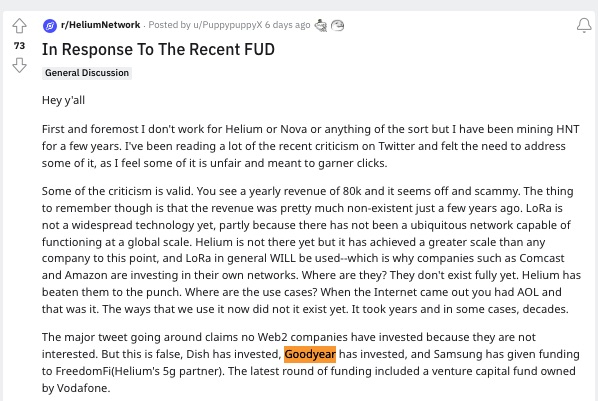.@Helium supporters have been accusing me of FUD.
To encourage one another to stay positive, they cite exciting corporate partnerships such as... @Goodyear Tire & Rubber.
Maybe I can help them perform a sanity check before they pin their hopes on this promising "customer".



To encourage one another to stay positive, they cite exciting corporate partnerships such as... @Goodyear Tire & Rubber.
Maybe I can help them perform a sanity check before they pin their hopes on this promising "customer".




Believers of the Goodyear/Helium partnership envision a future where your vehicle connects to the internet... through its tires.
Inspiring.
I'd hate to burst their bubble that a Goodyear Ventures investment with the goal to "learn about new mobility" isn't proof of real demand.
Inspiring.
I'd hate to burst their bubble that a Goodyear Ventures investment with the goal to "learn about new mobility" isn't proof of real demand.

To learn more, I watched this presentation by @AbhijitCVC of Goodyear Ventures:
Does Goodyear have a plan for giving tire sensor devices their own internet connection?
Not really, says Abhijit: "Assume we have the right sensors, and we don't yet..."
Does Goodyear have a plan for giving tire sensor devices their own internet connection?
Not really, says Abhijit: "Assume we have the right sensors, and we don't yet..."
This slide presents Goodyear's next steps. They're going to "explore use cases", i.e. they don't yet have a clear one.
When you're pinning your hopes on a vague, futuristic-sounding slide from a corporate VC, you're on track to be a #BloatedMVP of Goodyear Blimp proportions.

When you're pinning your hopes on a vague, futuristic-sounding slide from a corporate VC, you're on track to be a #BloatedMVP of Goodyear Blimp proportions.


I'm not spreading gratuitous FUD here. I've just heard enough startup pitches to call out the #HollowAbstractions.
The reality on the ground is that Goodyear has no compelling use case. Neither does Helium's LoRaWAN network to date.
I fixed that tweet for you, @AbhijitCVC.
The reality on the ground is that Goodyear has no compelling use case. Neither does Helium's LoRaWAN network to date.
I fixed that tweet for you, @AbhijitCVC.

@AbhijitCVC .@AbhijitCVC thanks for the pic of your team gluing a sensor to a tire, but the key question that remains unvalidated is whether a car's tires should be architected to connect directly to the internet using a decentralized network of LoRa hotspots.
https://twitter.com/AbhijitCVC/status/1554484605201293312
• • •
Missing some Tweet in this thread? You can try to
force a refresh












